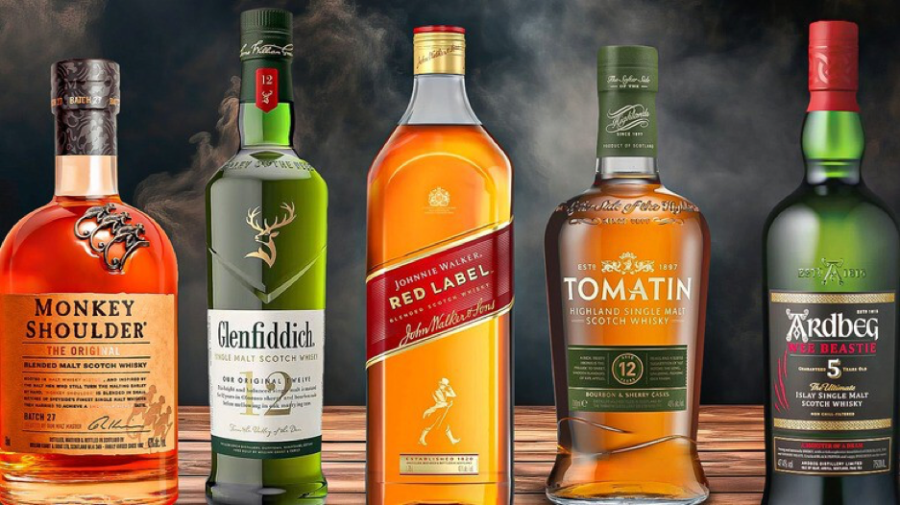
We went beyond simply compiling a list of lesser-known yet delightful whiskies. This selection includes familiar Scotch varieties you may have heard of but haven’t had the chance to taste, as well as exciting newcomers that could be entirely unfamiliar to you.
Our editors have personally tried every whisky on this list, and it takes into account not only taste but also value for money and availability. All of these whiskies should be fairly easy to acquire, so you can see this as a checklist and decide for yourself how highly rated they deserve to be.
Dewar’s 12-Year
Dewar’s is well-known for its entry-level blends. It offers a range of blended whisky aimed at the more affordable market. Nothing is wrong with that, but it does mean that its more expensive, higher-aged whiskies can get overlooked. Dewar’s 12-year is a perfect example of that, as it offers an impressive balance and smoothness that you may not associate with this type of whisky. Age-statement blends are rarer than single malt counterparts, but Dewar’s show why it shouldn’t always be that way.
On the nose, you get many of the notes you’d want from an expensive single malt, such as vanilla, dried fruit, citrus, and a subtle touch of oak. It has a well-rounded complexity you may expect from the longer aging process. These aromas continue through to the palate, joined by a spicy warmth that is presented with a velvety mouthfeel. It all adds up to a whisky that is excellent value for money and a big step up from the more famous White Label.
Clynelish 14-Year
Clynelish is another distillery that gets a lot of love from experienced enthusiasts but not from those who aren’t as well-versed in Scotch. Its expressions often fly under the radar and don’t get the widespread recognition they probably deserve. Clynelish whisky has a distinctive character, and you can often easily pick it out during a blind tasting, most notably due to its waxy mouthfeel. The best example of what a great Clynelish whisky offers is its 14-year.
The most distinctive notes you’ll get on the nose are those of honey and citrus. The aforementioned waxiness is notable on the palate, combined with a range of orchard fruits, a coastal salty influence, and a spicy warmth. This Scotch is pleasantly rich and has an impressive amount of depth. Its lack of widespread popularity is perhaps because it’s not marketed as heavily as other Diageo-owned distilleries, but whatever the reason, you shouldn’t let the 14-year pass you by.
Ardbeg Wee Beastie
Of all the whiskies on this list, the Ardbeg Wee Beastie probably presents the greatest value for money. For such a youthful whisky, it has an incredible depth of flavor that many older Scotches don’t have. Called the “Wee Beastie,” Ardbeg takes the unique step of giving this young whisky an age statement as it has been matured for a minimum of 5 years. While it may not boast the same age statement as some of its older siblings, such as the Ardbeg 10-year, Wee Beastie is a powerhouse of peat that deserves recognition for its captivating profile.
That smoke hits you immediately on the nose, and it’s joined by many more earthy notes and a hint of medicinal iodine. Its boldness is evident on the palate and is joined by sweeter and brighter tastes, such as vanilla and citrus. There is plenty of pepper on the finish, which is much longer than you’d expect from a 5-year-old whisky. Perhaps what we love most about the Wee Beastie is that it’s an excellent entry point for those who want to try a robust island whisky.
Glenmorangie Quinta Ruban 14-Year
Glenmorangie is a popular distillery. In fact, it has so many expressions that any particular one is in danger of getting lost in the crowd. While that’s true, we’ve included this whisky because of how it has matured. Most whiskies are matured in ex-bourbon casks, with sherry often used for premium Scotches. Other types of pre-seasoned casks can also be used, including rum, wine, beer, and port. The Quinta Ruban 14-year uses the latter as it first uses bourbon casks before it’s transferred to port casks from Portugal. If you’re unfamiliar with port, this may lead you to overlook this beautiful whisky.
Even if maturation in port casks doesn’t sound appealing, you should at least try them. As with the Quinta Ruban, port-matured whiskies often have a luscious mouthfeel and a fantastic interplay of flavors. On the nose, you get a complex aroma of dark chocolate, cherries, and a subtle hint of oak. On the palate, those notes develop into a balanced mix of red berries, toffee, and gentle spice. Glenmorangie Quinta Ruban 14-Year perfectly showcases the art of cask finishing and is worth seeking out if you want to know how port can influence a great Scotch.
Caol Ila 12-Year
For a small island, Islay has nine active distilleries. Of those, Ardbeg, Lagavulin, and Laphroaig are not only the most well-known but also produce whisky that encapsulates everything you expect from an Islay Scotch with the heavily peated profiles. Despite the revered reputation of Islay whiskies, Caol Ila often remains underrated, overshadowed by more heavily marketed counterparts. However, this 12-year expression deserves attention for its nuanced complexity and well-balanced profile. On the nose here, you get a fantastic mix of smoke, citrus, and a subtle saltiness.
Its position on the rugged Scottish coastline is notably imparted on this Scotch. The earthy notes continue onto the palate but aren’t quite as dominant as some of the other distilleries mentioned. It’s joined by many sweeter notes, including vanilla, along with a hint of fruits. Overall, this whisky gives you a surprisingly approachable and sophisticated experience. For those who like the peat influence on whisky but can sometimes find it a little too much, you’ll find Caol Ila 12-Year strikes the perfect balance.
Laphroaig Quarter Cask
The reason that we’ve put the Laphroaig Quarter Cask on this list is a mixture of many of the reasons we’ve looked at above. It has a unique maturation process, the distillery produces a much more famous expression in the form of its 10-year bottle, and it has no age statement. Despite its niche appeal, this expression deserves recognition as a unique and memorable whisky. From the moment the bottle is opened, the unmistakable aroma of Laphroaig’s peat smoke, seaweed, and medicinal notes dominate the senses.
The “Quarter Cask” name comes from the smaller casks used for the maturation process, which intensifies the interaction between the whisky and the wood. This leads to a rich and complex flavor profile, with the most dominant notes being brine and vanilla, along with a delightful interplay of sweet and savory notes. The finish is long-lasting, leaving a lingering warmth that shows that you don’t need an age statement to have a deep character in your Scotch. The Laphroaig Quarter Cask may not be for the faint of heart, but its boldness and authenticity set it apart from many other young Scotches.
Loch Lomond 12-Year
Loch Lomond is a distillery that struggles to get the recognition it deserves. It seemingly puts a lot of effort into its marketing but doesn’t have the same level of popularity as many of the other whisky-makers on this list. It makes the Loch Lomond 12-year an underrated gem in the realm of single malt whiskies. The Highland Scotch unveils a captivating array of tasting notes that showcase the richness of its character. The nose is greeted with a delightful blend of heather, honey, and a subtle touch of more earthy notes.
The palate has a well-balanced combination of orchard fruits, oak, and a touch of butterscotch. The unique combination of straight and swan neck stills no doubt contributes to the layers of flavor that you get from each sip. It’s an approachable and affordable whisky with an impressively long finish that will leave you wanting more. Unfortunately, Loch Lomond’s 12-year often exists in the shadows of more prominent single malts. However, its understated charm and complexity make it a whisky worthy of exploration.
Sources: AirGuide Business airguide.info, apple.news, Tasting Table







